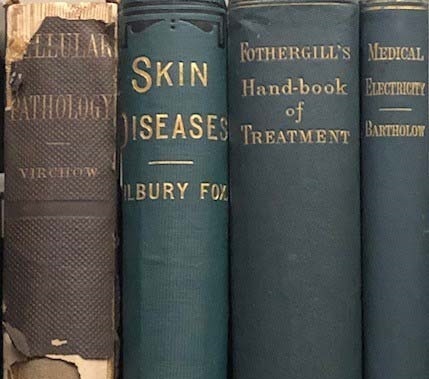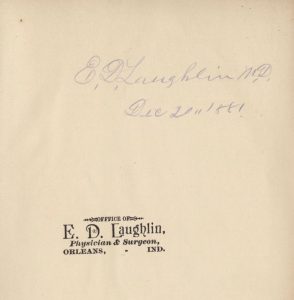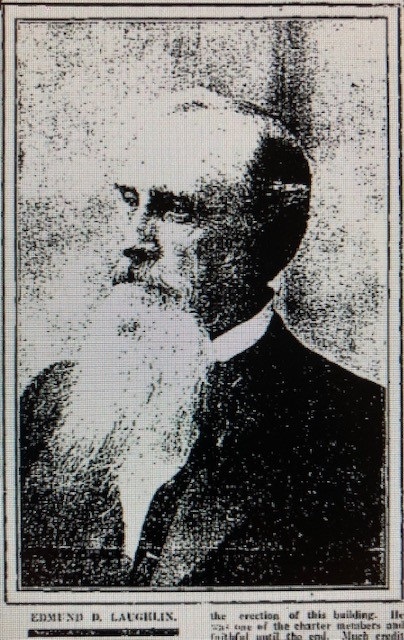
Purchase Tickets
From the Cataloger’s Desk: Paging Dr. Laughlin!
August 15, 2019

I find old medical books fascinating. They rank high on my list of favorite printed materials to catalog – right up there with yearbooks, cookbooks and maps. I’m no medical expert, but I enjoy reading about various ailments and how they were treated long ago. I also appreciate the accompanying illustrations. Far from being gory or graphic, they are often quite beautiful. I was excited, therefore, when the following titles came across my desk:
• Cellular pathology, as based upon physiological and pathological histology … (1860)
• Skin diseases: their description, pathology, diagnosis, and treatment (1879)
• The practitioner’s handbook of treatment: or, The principles of therapeutics (1880)
• Medical electricity: a practical treatise on the applications of electricity to medicine and surgery (1881)
 As I began cataloging these books, I was happy to discover a clue relating to their provenance. All four have the following stamped on a flyleaf: “Office of E.D. Laughlin, Physician & Surgeon, Orleans, Ind.” Two also bear the doctor’s signature and dates. Naturally, my curiosity was piqued, so I decided to learn more about Dr. Laughlin.
As I began cataloging these books, I was happy to discover a clue relating to their provenance. All four have the following stamped on a flyleaf: “Office of E.D. Laughlin, Physician & Surgeon, Orleans, Ind.” Two also bear the doctor’s signature and dates. Naturally, my curiosity was piqued, so I decided to learn more about Dr. Laughlin.
 Edmund D. Laughlin was born May 28, 1827, in eastern Ohio. In 1838, his family moved to Indiana and eventually settled in Parke County. After leaving common school, Dr. Laughlin attended Friends’ Manual Labor School at Bloomingdale (later known as Bloomingdale Academy). He took a medical course at the University of Michigan, earned a diploma from Miami Medical College at Cincinnati, and graduated from Bellevue Medical College of New York with the degree of Medical Doctor. He began his career in Rossville, Indiana, then moved his family to Orleans in 1862, where he practiced medicine for the next forty-one years. He passed away February 5, 1915.
Edmund D. Laughlin was born May 28, 1827, in eastern Ohio. In 1838, his family moved to Indiana and eventually settled in Parke County. After leaving common school, Dr. Laughlin attended Friends’ Manual Labor School at Bloomingdale (later known as Bloomingdale Academy). He took a medical course at the University of Michigan, earned a diploma from Miami Medical College at Cincinnati, and graduated from Bellevue Medical College of New York with the degree of Medical Doctor. He began his career in Rossville, Indiana, then moved his family to Orleans in 1862, where he practiced medicine for the next forty-one years. He passed away February 5, 1915.
According to his obituary, Dr. Laughlin discovered the method of detecting fractured bones by use of the stethoscope. That’s a pretty big deal! He was also involved with numerous professional and community organizations throughout his life, including the State Board of Health, the Indiana State Medical Society, the Indiana Medical College, the Orange County District Medical Society, the Board of Pension Examiners, and the Orleans Academic Association and Board of Education. During the Civil War, Governor Oliver P. Morton even made him Examining Surgeon for those exempted from the draft. What an amazing life and career!
 I enjoy imagining these books sitting on a shelf in Dr. Laughlin’s busy Orleans office over a century ago. Perhaps he referenced them when confronted with an unusual case? Or, maybe he sat at his desk reading up on the latest medical trends between appointments? This is part of what makes my job so fun – imagining the journey our books took before coming to their new home at IHS!
I enjoy imagining these books sitting on a shelf in Dr. Laughlin’s busy Orleans office over a century ago. Perhaps he referenced them when confronted with an unusual case? Or, maybe he sat at his desk reading up on the latest medical trends between appointments? This is part of what makes my job so fun – imagining the journey our books took before coming to their new home at IHS!
Sources:
[Edmund D. Laughlin obituary]. (1915, February 18). The Progress-Examiner, 35 (34). Retrieved from newspaperarchive.com.History of Orange County Indiana: a reproduction of the original “History of Lawrence, Orange and Washington counties” 1884. (1965). Paoli, IN: Stout’s Print Shop.









